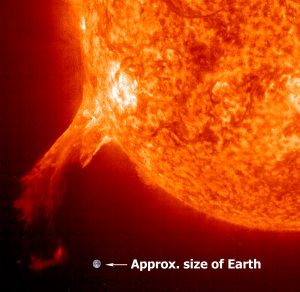The long journey of a photon flux to your solar panel
In order to understand how solar electricity is generated, it might help to go back a few steps and see how it all begins, in our own solar system's star, the Sun.
At the core of our sun, a star that is 4.6 billion years old, a thermonuclear reaction mashes up vast quantities of hydrogen and helium, releasing huge amounts of energy in the process. Photons that are created as a by-product of this violent galactic dance are now stuck between the expanding gases emanating from the core of the Sun and its immense gravitational force. It can take a photon a million years to navigate this tug-of-war and reach the surface of the Sun. Finally, a burst sends a column of energy into the vacuum of space, hurtling along at the speed of light towards our planet. It may have taken a million years to reach the surface, but once a photon sets itself free from the Sun, it takes it only eight minutes to reach our planet.

A column of photon flux leaving their mother star (image credit: NASA)
When it reaches the top of the Earth's atmosphere, it is packing 1361 watts per square meter of energy (this value is also called the solar constant), enough to cause serious biological damage. Fortunately, as the photons pass through various layers of the atmosphere some of this energy is absorbed. Further down below, where water molecules come together to form clouds, another 20% of the energy is reflected back to space. The remaining rays of light make their way through the lower layers of the atmosphere, passing through dust particles and air pollution to reach your solar panels. 150 million kilometers and 1 million years later, the photon that started its journey at the core of the Sun finally reaches your panels and is then converted into electricity in a process called the photovoltaic effect.
Photon flux and the photovoltaic effect
Photon flux is an important concept in solar energy. If we are interested in knowing how much power we can generate from a solar panel, we need to determine the amount of photons that are hitting the surface of our panels at any given time ("flux" is just a technical term that denotes a quantity passing through a given surface area). Photon flux is generally measured as the number of photons per second per square meter.
The photovoltaic effect is simply the conversion of light into electric current. This term is derived from the Greek word for light ("photo") and a historical reference to Alessandro Volta, inventor of the battery and the namesake of the electrical unit "volts". This effect is only observed when light hits certain types of semiconductor materials, such as silicon. Thin semiconductor layers are placed on a solar panel to form an electric field, positive on one side and negative on the other. Within the solar panel, photons of light are absorbed and electrons from the atoms in the semiconductor material are released. By using electrical conductors attached to the positive and negative sides of the panel, an electrical circuit is formed and electricity is generated.
There you have it: human ingenuity at its best, converting photons from the Sun into power to charge your favorite appliances and electronic devices.